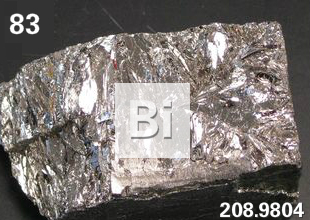Chemical properties of Bismuth
- Atomic number:
- 83
- Atomic mass:
- 208.9804 g.mol -1
- Electronegativity according to Pauling:
- 1.9
- Density:
- 9.80 g.cm-3 at 20°C
- Melting point:
- 271 °C
- Boiling point:
- 1420 °C
- Vanderwaals radius:
- 0.152 nm
- Ionic radius:
- 0.074 nm (+5) ; 0,120 nm (+3)
- Isotopes:
- 14
- Electronic shell:
- [ Xe ] 4f14 5d10 6s2 6p3
- Energy of first ionisation:
- 703 kJ.mol -1
- Energy of second ionisation:
- 1610 kJ.mol -1
- Energy of third ionisation:
- 2466 kJ.mol -1
- Energy of fourth ionisation:
- 4362,3 kJ.mol -1
- Energy of fifth ionisation:
- 5394 kJ.mol -1
- Standard potential:
- 0.32 V ( Bi3+/ Bi )
Bismuth is a white, crystalline, brittle metal with a pinkish tinge. Bismuth is the most diamagnetic of all metals, and the thermal conductivity is lower than any metal except mercury. It has a high electrical resistance, and has the highest Hall effect of any metal (that is, the greatest increase in electrical resistance when placed in a magnetic field). Bismuth is stable to oxygen and water but dissolves in concentrated nitric air. All bismuth salts form insoluble compounds when put into water.
Applications
Bismuth metal is used in the manufacture of low melting solders and fusible alloys as well as low toxicity bird shot and fishing sinkers. Certain bismuth compounds are also manufactured and used as pharmaceuticals. Industry makes use of bismuth compounds as catalysts in manifacturing acrylonitrile, the starting material for synthetic fibers and rubbers. Bismuth is sometimes used in the production of shot and shotguns.
Bismuth in the environment
The most important ores of bismuth are bismuthimite and bismite. Bismuth occurs naturally as the metal itself and is found as crystals in the sulphides ores of nickel, cobalt, silver and tin. Bismuth is mainly produced as a by-product from lead and copper smelting, especially in USA. The chief areas where it is mined are Bolivia, Peru', Japan, Mexico and Canada, but only to the extent of 3.000 tonnes per year. There is no reliable estimate of how much bismuth is available to be mined, but it seems unlikely than there will ever be a shortage of this metal.
Applications
Bismuth metal is used in the manufacture of low melting solders and fusible alloys as well as low toxicity bird shot and fishing sinkers. Certain bismuth compounds are also manufactured and used as pharmaceuticals. Industry makes use of bismuth compounds as catalysts in manifacturing acrylonitrile, the starting material for synthetic fibers and rubbers. Bismuth is sometimes used in the production of shot and shotguns.
Bismuth in the environment
The most important ores of bismuth are bismuthimite and bismite. Bismuth occurs naturally as the metal itself and is found as crystals in the sulphides ores of nickel, cobalt, silver and tin. Bismuth is mainly produced as a by-product from lead and copper smelting, especially in USA. The chief areas where it is mined are Bolivia, Peru', Japan, Mexico and Canada, but only to the extent of 3.000 tonnes per year. There is no reliable estimate of how much bismuth is available to be mined, but it seems unlikely than there will ever be a shortage of this metal.


